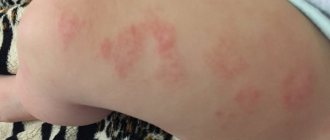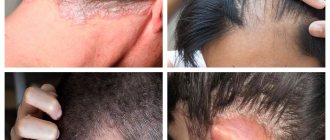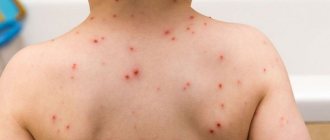Last update: 03/03/2021
Dermatitis is an acute inflammation of the skin, which can be caused by both aggressive external factors and an allergic reaction. Irritation on the buttocks most often appears in children and bedridden patients - from exposure to aggressive substances from feces and urine on the skin, insufficient air access, and friction from the diaper.
In babies, dermatitis on the butt can also be an allergic reaction to cosmetics, a certain type of diaper, synthetic or brightly colored fabrics.
About the disease
Diaper rash is irritation of the baby's delicate skin due to mechanical friction or secretions (urine, feces).
The skin often suffers in natural folds (perineum and under the arms). Inflammation primarily occurs without infection, especially with a change in diet, which changes the properties of feces. However, due to the nature of children's skin, a bacterial or fungal infection can quickly develop, requiring immediate treatment. Diaper rash most often occurs in children who are bottle-fed, have excess body weight for their age, have digestive disorders, are prone to allergies, have lactase deficiency, and abnormal kidney development. Excessive wrapping, high room temperature, untimely bathing, prolonged stay in wet diapers or a diaper of the wrong size contribute to the development of diaper rash.
In practice, to select the correct treatment method, the following classification of diaper rash is used:
- diaper dermatitis - redness and rash appear only in those places that are constantly in contact with wet diapers;
- allergic ring - occurs around the anus due to a food allergy that develops to a new food product;
- seborrheic eczema - the skin of the lower abdomen and genitals becomes rough, swollen, oily to the touch, the border with normal skin is clear, looks like a hyperemic (bright red) huge spot;
- intertrigo - affects natural folds (gluteal, elbow, popliteal and others), against the background of redness, weeping cracks form, this condition is provoked by increased humidity;
- genital candidomycosis - occurs when a fungal infection is attached, has the appearance of red spotty rashes;
- impetigo - occurs when a pyogenic infection occurs; it first appears as separate and then small draining ulcers, which form crusts after drying. Impetigo in children forms on the buttocks.
Diaper rash at the initial stage can be eliminated with good care, changing the brand of diapers and using a high-quality baby skin cream. In severe cases, etiotropic treatment is required, aimed at combating the infectious onset.
How do they manifest themselves?
The appearance of various rashes on your baby’s skin is a reason to consult a doctor. It is quite difficult to carry out differential diagnosis at home. Pediatric dermatologists deal with skin diseases. These specialists conduct a full clinical examination and examination of the baby, as a result of which they will be able to establish the correct diagnosis.
The severity of symptoms for different diseases may vary. The intensity of the color of skin rashes also differs significantly. At the height of the acute period of the disease, the spots on the skin become more intensely colored, then gradually fade. After cleansing the skin rashes, areas of depigmentation usually remain on the skin. They appear as white or light spots that disappear completely after a few weeks.
Infectious diseases are characterized by the appearance of skin rashes on almost all parts of the body: from the face to the heels:
- The appearance of white patches on the skin can be caused by the disease vitiligo. This disease is characterized by the formation of fairly large white spots on the skin, but there are no other adverse symptoms. Usually the spots are irregular in shape and have bizarre outlines. Doctors consider this condition more cosmetic than pathological. Most often, the first symptoms occur in adolescence.
- The combination of skin elements and systemic disorders is very unfavorable and always indicates the presence of persistent pathology in the body. One of these diseases is tumorous sclerosis. This condition is congenital. It is characterized by a child’s lagging behind in physical and mental development, the occurrence of epileptic seizures, as well as the appearance of large spots on the skin that cover the skin on the hands and feet.
- Pale large spots can occur in children and with various pathologies of the immune system. Congenital or acquired immunodeficiencies are manifested by the appearance of fairly light areas on the skin. The highest risk group includes premature babies, as well as babies born during a complicated pregnancy. Congenital anomalies that lead to persistent metabolic disorders also contribute to the appearance of white patches on the child’s skin.
- Psoriasis is a fairly common dermatological pathology, which is accompanied by the appearance of various spots on the skin. This is a family disease that is inherited. As a rule, the first manifestations of the disease occur in adolescence. This pathology is characterized by the appearance of itchy spots, which can be located on the back, face, upper half of the body, knees and elbows. Psoriatic skin elements are usually red in color and quite rough to the touch.
Skin rashes can come in a wide variety of shapes and forms. This variety of clinical options makes it very difficult for doctors to establish the correct diagnosis. Quite often, in order to determine exactly the cause of the appearance of spots on the skin, a large complex of various diagnostic methods is carried out. The length of time that rashes remain on the skin can vary and depends on the cause of the disease that caused them to appear on the skin. Red spots that occur as a result of various childhood infections usually completely disappear from the skin within 7-14 days from the moment the first rash appears. Fungal variants take a little longer.
Diaper rash symptoms
Diaper rash is manifested by characteristic skin changes. From a practical point of view, the following 3 degrees of severity are distinguished:
- mild – the skin only turns red (hyperemia);
- medium - against the background of reddened skin, erosions, microcracks, and sometimes small ulcers are visible;
- severe - in addition to reddened skin and cracks, areas of erosion, ulcers are visible, the epidermis peels off in places. Almost always there is an infection, bacterial or fungal. An extreme manifestation of severe disease is microbial eczema, in which lesions are aggravated by an autoimmune process.
The baby's behavior with first-degree diaper rash does not change in any way; skin damage is detected when changing diapers. In the second degree, the child is bothered by burning, pain and itching, which is manifested by tearfulness, moodiness, anxiety, and poor sleep. The addition of a bacterial infection is manifested by an increase in body temperature, loss of appetite and other general symptoms.
Dermatomycosis - the cause of spots on the legs
The parasitic fungi Trichophyton and Microsporum, the causative agents of ringworm, feed on keratin in the skin. Red spots on a child's feet appear after infection with foot fungus in a pool or bathhouse. Pityriasis versicolor or solar versicolor are small, non-inflammatory red spots. The causative agents of the disease are considered to be two types of fungi (pitirosporum, malassezia).
Signs of ringworm
- a pink-red spot similar to a ring with peeling in the central part;
- formation of bubbles, weeping (not always);
- cracks on the soles of the feet, between the toes;
- irritation, burning, itching.
Sunburn spots remain light on tanned skin of the legs, arms or back.
It is recommended to lubricate the affected skin on the legs with the antifungal agents Clotrimazole or Ketoconazole (if the child is over 2 years old). Imported Mycoseptin ointment is also suitable. The external remedy prescribed by your doctor should be applied to clean, dry skin at least twice a day. Ridoxol ointment is a Russian drug for the treatment of microsporia in children. Promotes rapid restoration of the skin.
Auxiliary and folk remedies:
- oil solution of eucalyptus extract “Chlorophyllipt”;
- rosehip seed oil, sea buckthorn;
- chamomile infusion;
- tincture of calendula.
Propolis tincture, celandine juice, lemon juice, birch tar, and apple cider vinegar have antifungal properties. Healing solutions are used for lotions, compresses, or gently rubbed into the affected area. Lichen spots in young children can be lubricated with the juice of calendula or chamomile flowers. The listed folk remedies reduce itching, which causes the child to scratch the skin and cause a bacterial infection. In this case, treatment with antibacterial ointments will be required.
Causes of diaper rash
Diaper rash occurs in almost every baby, even with ideal care.
This happens because the skin is the most vulnerable part of a baby’s body. Children's skin is thin and loose, its protective function is not fully formed. When soaked in liquid, the skin of children swells (macerates), which contributes to damage even with a slight touch. In children of the first year of life, the so-called water-lipid mantle is not sufficiently formed - the first skin barrier, a film on the stratum corneum of the epidermis. All other barriers - cellular, humoral - are also underdeveloped due to age. Therefore, babies are susceptible to local bacterial infection, which quickly spreads from the primary focus to the underlying skin.
The immediate cause is prolonged contact with moisture and ammonia salts, which are formed during the breakdown of urea. Feces contain enzymes (protease and lipase) that literally eat away at the skin. With diarrhea, diaper rash can develop within a few hours.
Some children's skin may react to certain components of baby cosmetics, a new brand of diapers, or other hygiene products. This does not mean that children's products contain low-quality components, it is just that the child has increased individual sensitivity to certain substances.
Common Causes of Red Spotted Rash on Legs
Erythema toxicum - red spots on the body of a newborn baby. The rash goes away quickly and does not harm the baby’s health. Common causes of spots on the legs in children of early and preschool age are infections and allergic dermatoses. In developed countries, every year fewer cases of diseases of infectious etiology are registered, while at the same time allergization of the child population is increasing.
The reasons for the appearance of red dry spots on the legs of a child and blisters against the background of hyperemic skin:
- Dermatoses (urticaria, toxicerma, atopic and allergic dermatitis, eczema).
- Infectious diseases (chickenpox, measles, rubella, scarlet fever, pityriasis rosea, streptoderma).
- Diaper rash, prickly heat.
- Parasitic diseases.
- Insect bites, ticks.
- Fungal skin lesions.
- Hormonal disorders.
- Pathologies of internal organs.
- Systemic lupus erythematosus.
- Psoriasis (scaly lichen).
If parents notice a red, rough spot on a child’s leg, then most often they consider two reasons - lichen and allergies. It is possible to combine them, because the allergic component is present in many diseases. People react differently to the same infectious agents, chemical compounds or physical phenomena. Local inflammation and the appearance of spots on the skin are most typical for children who received from their parents a genetic predisposition to such a response to the action of internal and external factors.
Treatment of diaper rash
Treatment methods depend on the severity and type of diaper rash.
In the first degree, you need to care for the baby more carefully and let the skin dry out. It is advisable to change diapers and diapers more often so that the baby's skin is not wet. When swaddling, it is advisable to wash the buttocks and genitals, especially after defecation, and allow the skin to dry naturally. After this, you need to lubricate the problem areas with baby cream. It’s good if the baby takes air baths (lying naked for a while). After an evening bath, you need to wait until the baby is completely dry and only then swaddle.
For more severe degrees of diaper rash, the following medications are used:
- drying;
- antiallergic;
- anti-inflammatory;
- wound healing;
- antiseptic.
By combining careful care and local medications prescribed by a doctor, it is always possible to cope with diaper rash in a short time.
Allergy is the cause of red rash on legs
The color of the spots varies from pink to dark crimson, the shape is round or oval, with smooth and scalloped edges. The appearance of such symptoms is observed in a variety of diseases. Spots on the knees and legs occur as a result of immunoallergic processes. In these cases, the child suffers from itching and pain. If the spot on the leg does not itch, then the cause of its appearance may be reactions of the autonomic nervous system to heat or cold, high humidity, or stress.
Taking antihistamine syrup or drops orally and external use of an antiallergic gel will help eliminate discomfort. Antihistamines (tablets, drops and syrups): “Loratadine”, “Dezal”, “Cetirizine”, “Parlazine”, “Eslotin”, “Erius”, “Zirtec”, generic - “Zodak”. To treat red spots on the body of an infant, use Fenistil gel, Bepanten ointment, Depanthenol cream, and zinc ointment.
External agents for children over 2 years of age reduce inflammation and itching: Elidel, Desitin, Elokom, Cutivate.
It is recommended to exclude all potential allergens from the child’s menu and provide products to cleanse the gastrointestinal tract of toxins. The preparations “Enterosgel”, “Lactofiltrum”, and activated carbon have sorbing properties. Allergens include milk, cheeses, eggs, nuts, chocolate, citrus fruits, strawberries.
Plaques and flaky patches on a child's knees may be a symptom of psoriasis. If the rash is of immunoallergic origin, then treatment with antibacterial or antifungal ointments will cause a deterioration in the skin condition. They give a sedative to prevent the baby from scratching the plaques. You definitely need to show your child to a dermatologist.
Prevention of diaper rash
Preventive measures are varied and based on centuries of experience in caring for an infant.
Everything that touches children's delicate skin should be natural, including fabrics and cosmetics. Synthetic items should be avoided. When bathing, you need to thoroughly rinse all folds. After each bowel movement, the baby is washed with warm water, sometimes several times in a row, until completely clean. Once or twice a week it is recommended to bathe in a weak decoction of string or chamomile. From time to time, all diapers and diapers need to be removed, giving the baby the opportunity to move his arms and legs freely, and the skin to “breathe.” If the first signs of inflammation appear on the skin, suspicious areas should be treated with a weak (pink) solution of manganese. Afterwards, do not wipe it off, but let it dry. The baby should be closely monitored, and if the inflammation does not go away within 1-2 days, contact a pediatrician. You should also pay close attention to complementary foods. It is unknown how the baby will react to the new product. The first fruit or vegetable complementary food should consist of only one vegetable or fruit. The same applies to cereals, dairy and meat products. You can mix products only after each individual product has been tested for tolerance. A new product should be given for the first time in a small portion (about 1 teaspoon) so as not to cause harm.
Powders and oils used for care should also be tried separately.
The pediatric doctors at the SM-Doctor clinic have extensive practical experience. Experts will advise you on the best care products and help you quickly get rid of diaper rash. Contact qualified pediatricians so that your baby can live an active and joyful life!
Pityriasis rosea
When the fungus that causes lichen occurs, red spots appear on the child’s body; a photo of them will help you easily distinguish them from other rashes. They usually form where there is sweating. These spots itch and flake, they are dry.
Additional symptoms may include fever and swollen lymph nodes. Children become infected with lichen from dogs and cats.
Since there are several types of lichen, you should consult a doctor to determine what to do in a particular case. An accurate diagnosis is made after analysis - scraping from the affected area of skin.
Viruses and bacteria - causes of leg rashes
Diseases of viral and bacterial etiology are accompanied by fever, general intoxication, and respiratory catarrhal phenomena. Scarlet fever, rubella, and measles are characterized by the appearance of a small-spotted, pink-red rash on the legs, torso, and face.
Chicken pox
A common, highly contagious viral infection. A child's rash occurs all over the body, not just on the legs. Spots, nodules and blisters exist on the skin at the same time. Parents should take care that the child does not scratch them, otherwise the risk of superinfection increases.
Pityriasis rosea
The pathogens also belong to herpes viruses and are activated in the body when the immune system is weakened. First, a large red spot forms on the leg in the hip area or on the waist. The diameter of the “mother” plaque is up to 6 cm. The “daughter” spots are smaller - up to 2 cm. The disease goes away without treatment in 0.5–2 months, but oral antihistamines and external use of glucocorticosteroid ointments may be required.
Erythema infectiosum
The disease is caused by herpes viruses. At first, symptoms appear like those of a cold; after a few days, red spots appear on the body. Bed rest will be required. Medicines include antipyretics and antihistamines.
It is necessary to teach the child the rules of hygiene and ensure compliance with basic requirements. You cannot use someone else’s shoes or touch yard animals. Signs of skin diseases in four-legged pets are usually visible to the naked eye. It is recommended not to delay a visit to a dermatologist if a rash appears on a child’s legs.
Why does the red spot on the skin peel off?
Every mother is worried about red spots on her child's body. They usually appear unexpectedly and may cause inconvenience to the child or, conversely, not bother him. In some cases, red spots on the skin go away quickly on their own, but most often they are a sign of some disease.
The appearance of spots on the body and face of a child is the most common symptom in babies. There are many reasons why red rashes may appear on a child's skin. When they appear, it is necessary to monitor the following factors:
- spots appear periodically or constantly;
- size and area of the rash;
- rash color (pink, bright scarlet or burgundy);
- time of appearance (in the evening, after sleep, after eating, after swimming, walking, etc.);
- presence of itching or peeling.
Allergy rash
The reason why a child is covered with red spots is often an allergy. Young children are quite often susceptible to allergies and their skin manifestations: rashes, hives, peeling skin and itching.
Most often, rashes in children appear due to food allergies. In infants, an allergic reaction throughout the body may occur due to the fact that the mother's food contains an allergen. Depending on the body's reaction, red spots may appear on a certain area of the body or cover it completely.
What do scaly spots on a child’s body look like?
Flaky spots on your baby's skin can be red or pink, round or oval in shape. The spot can be either single or from several formations. Small specks may appear scattered.
Spots that begin to peel off most often appear on the child’s face, neck, back, and on the bends of the elbows. Depending on the color, shape and location, the doctor can determine what disease the child has.
In young children under two years of age, scaly spots can occur for several reasons:
- allergy;
- diathesis;
- Diaper rash.
Diaper rash in a baby usually appears in the diaper area due to irritation from substances contained in diapers. They can also appear due to low-quality baby care products: cream, powder, ointment. Diaper rash usually appears as a red, round spot with sharply defined edges.
Symptoms of diathesis most often appear on the baby’s cheeks. This happens due to improper nutrition of the mother of the baby who is feeding the child. The baby's body does not accept some of the substances that come from mother's milk.
Allergies appear during artificial feeding and the transition from breast milk to a full-fledged diet. Occurs due to baby food, other foods containing dyes or flavors.
Features of baby skin
The delicate skin of a newborn has some features:
- She is hypersensitive and instantly reacts to any external or internal stimuli.
- The underdevelopment of the sweating system in newborns also affects the condition of the baby's epidermis. The baby's sweat glands are not able to release all the excess heat outside, which only enhances the so-called “greenhouse effect” inside the diaper.
- The skin of a newborn is rich in lipids, which dissolve urine and feces well, thereby causing irritation and redness on the baby’s bottom.
That is why a baby’s skin requires special care and respect.









